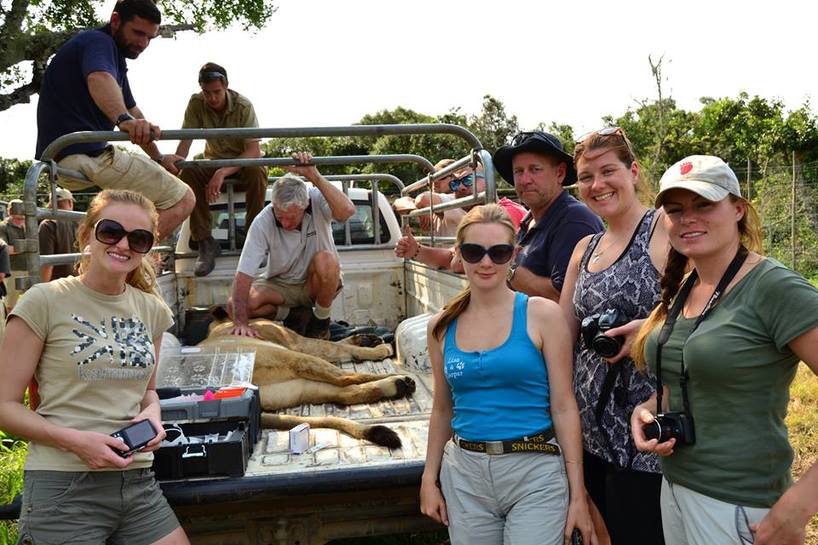Kariega Conservation Volunteer Update: Oct 2015

September and October are lovely months in the Eastern Cape. The weather is balmy, the bush is green and the smell of rain is ever present in the air. These two months have been great for volunteering and the volunteer programme worked hard at numerous projects on the reserve.
General Maintenance
During September and October the Kariega volunteers cleared three roads; Eskom road, Waterfall and Oxpecker. The road leading to the River hut was also repaired by packing rocks and stones to avoid deep mud and getting stuck. During October they cleared and fixed Forrest road and Kayalink. Forrest road has been closed for quite a long time, a tree has fallen over that we cleared away and the bushes on the side have been trimmed back. Where the road crosses a water creek, the volunteers packed rocks to make it driveable again.
The volunteers helped with constructing a boma for the guests, where they can have a bush breakfast, lunch or dinner. We planted mountain aloes to make it esthetical more attractive. They helped building a fire pit and area to serve the food as well as digging in the tables and benches. The path way to the area was cleared and sand was wheel borrowed in to give it a smooth surface. The location looks lovely and already some great breakfasts and dinners have been served to the guests there. The volunteers together with the rangers were also treated to a lovely dinner to show appreciation for our hard work.
The boma, where animals are kept before release onto the reserve, was also cleaned out. The volunteers were cutting down bushes and grass and trimming trees, so it will always be ready should we need it.
The volunteers cleaned up Main Lodge by picking up litter around the chalets, main lodge and the boma area. The blue duiker walking trail close to Main Lodge was also cleared and cleaned up.
Nursery & Spekboom Project
During October the volunteers cleaned up the nursery that we are busy planting indigenous trees and plants with the aim to use them again in landscaping around the lodges. We planted Cape Chestnut seedlings and more Coral tree seedlings.
The volunteers planted 193 Spekboom cuttings during September and October. The Spekboom plant is very hardy and grow very well in this region. It is a great plant to stabilise soil where there might be a possibility of erosion. Not only is it a great source of food to many browsing animals like elephants and kudu, but it also fixates carbon dioxide very efficiently.
Bush Encroachment Control
Bush encroachment is when woody vegetation start to grow very dense and the competition for light, nutrients and water increase between the woody vegetation and grass. This can escalate very quickly it not attended to. The Searsia sp and Acacia sp. are the two most common species tending to encroach. Therefore the volunteers poison specific areas where bush encroachment is a problem to try and control the problem. During September we poisoned Searsia sp. south of the elephant boma and during October we poisoned Acacia sp south east and north west of the Settlers Drift Lodge next to the Bushmans River.
Invasive Species Control
During September the volunteers eradicated Black Wattle trees seedlings and trees in great numbers north of Reception. This is a marshy area where the wattle trees thrive, sucking up litres and litres of water and nutrients that could have been used by indigenous trees and vegetation. The seedlings are pulled up quite easily and piled up to dry out, preventing it from taking up roots again. The bigger trees are chopped down with machetes or hand saws and then painted with KAPUT poison, that prevent the tree from sprouting and starting to grow again.
Research Projects
Rhino Spatial Movement
The volunteers continue to monitor the rhinos on Kariega Game Reserve and like mentioned in previous newsletters we do not reveal this information for safety reasons.
Lion Prey Selection Study
The volunteers were fortunate enough to be able to be apart of a lion darting. A young lioness were darted to accompany a new lioness in the boma. The volunteers located the lioness and stayed with her until the capture team arrived. She was darted and transported to the boma, where the veterinarian did some basic check-ups before she joined the new lioness. The two lionesses stayed in the boma for about five weeks. The new lioness and the old lioness were put together in the boma so that they will form a social bond. The two lionesses were released, but went their separate ways for now. There is a lot of dynamics going on in the pride and it is very interesting observing them.
Elephant Impact Study
During September and October the volunteers observed the elephants being mostly on the plains.
The spatial movement of the elephants can therefore almost predetermine what their diet preference will be, in this case grass. It has been found in previous studies that elephants’ diet consists of mostly grass during periods of good rainfall and in the dryer seasons more woody vegetation.
The volunteers observed and recorded the diet preference of the elephants. The volunteers also recorded how long an elephant consumed a specific plant.
Community and School Projects
The volunteers went to the Farmerfield Primary School a few times during September and October as it was also school holidays during September. During these visits the volunteers pulled their weight and continued with a part of the playground that we are developing for the kids. More old tyres were reused to create a hop-scotch structure for the kids and balancing structures to help develop muscle strength and balance. We are hoping to keep developing the playground and making the kids smile for a while.
The school received several supplies again from generous guests and volunteers which are very much appreciated.
Yours in Conservation, Frances van Pletzen, Volunteer Coordinator










